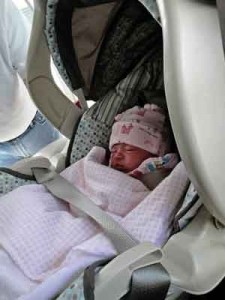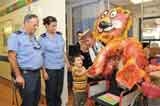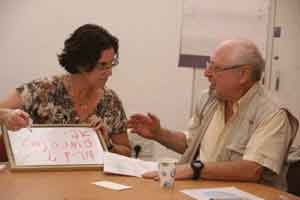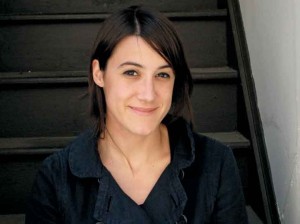Hadassah
Inside Look
Inside Hadassah: On Aspen, Aphasia and Art
Hadassah Magazine honors a talented writer, winner of this year’s Harold U. Ribalow Prize for a work of fiction on a Jewish theme. Sara Houghteling is an author who is drawn to Holocaust history and values literary tradition. Books are, indeed, keepers of memory and they transport us to unique times and places.
In this column, we focus on unusual journeys and programs in Israel, from a Year Course veteran’s return to her roots, to artwork traveling from a prison to a hospital, to caring for special populations. Through our reading of true stories and fine novels, voices from times past can guide us into building a brighter future. —Ruth G. Cole
Buckle Up, Baby!

By law, infants in Israel may not ride in cars without being properly strapped into a car seat. However, a recent survey conducted at Hadassah Hospital’s neonatal and obstetrics departments indicated that 5 out of 56 mothers were planning to take their newborns home in a car with no safety seat.
In response, Hadassah Medical Center began collaborating with Hadassah Taxis, a private company, and Beterem, the national center for child safety and health, to provide infant car seats for the ride home for parents leaving the hospital without one.
The taxi drivers have been trained to install the infant seats and to buckle in newborns. The seats themselves were donated by Shilav, a chain of children’s retail stores throughout Israel with a location on Hadassah’s Ein Kerem campus.
According to Israel’s National Road Safety Authority, there has been a rise in the percentage of children riding in cars unsafely in the past two years, from 31 percent in 2008 to 56 percent in 2009 (the most recent year for which data is available). Beterem claims that babies who are properly belted into car seats are 71 percent more likely to survive a road accident than those who are not.
Year Course, Revisited
In September 1968, Judy Cohen traveled from Massachusetts to join 34 other active Young Judaeans on Year Course. Together, they studied in Jerusalem, lived on a moshav, worked on a kibbutz and volunteered in the then 20-year-old state.
After Year Course, Cohen stayed in Israel, went to college, married, worked and raised a family. Over the years, Cohen fondly remembered her years as a Young Judaean and her time on Year Course. And so, after her husband passed away in 2007 and she decided she needed a career change, she came full circle and found herself back on Year Course once again—this time as staff.
“Today, as volunteering coordinator for [students in] Bat Yam, I have a feeling of coming home,” said Cohen, 60, who is now on her fourth Year Course. “Though Year Course has changed in many ways, it still is the same amazing experience. I guess you are never too old for Young Judaea!”
Raising Funds to Raise the Tower
Hadassah’s Tower Campaign held its first signature event last August, when Karen Davidson hosted a special evening at her home in Aspen, Colorado. The Sarah Wetsman Davidson Tower is named in honor of her late mother-in-law.
More than 60 philanthropists from the United States, Argentina, Venezuela, Panama, Switzerland and Israel attended the gathering, which was cohosted by Hadassah National President Nancy Falchuk. Guest speakers included Dr. Shlomo Mor-Yosef, director general of the Hadassah Medical Center; Dr. Chaim Lotan, director of the Heart Institute; and Dalia Itzik, Member of Knesset. Andrea and Moshe Silagi served as cochairs of the evening; Judy and Sidney Swartz, cochairs of the Tower Campaign, were the vice chairs for the event.
Facts About the Tower:
- The Sarah Wetsman Davidson Tower is the largest construction project under way in Jerusalem today.
- The new tower encompasses almost one million square feet and 19 floors.
- Begun in 2007, construction on the tower has reached the top floor, 14 stories aboveground.
- To date, the Tower Campaign has raised $235 million from private resources; the goal is $318 million for construction. Additional funds will be required for equipment and furnishings.
A Thoughtful Gift

Recently, a prison van arrived at Hadassah Medical Center in Ein Kerem bearing an unusual gift: It was a papier-mâché lion made by inmates at the Ofek Juvenile Prison, a maximum-security facility, for the patients in the pediatric hematology-oncology unit.
The lion was carefully designed and crafted by the inmates as part of the prison’s Sensitive Hands for the Community program in conjunction with Amutat Hayyim, a national organization for children with cancer.
“We are quite moved that the young inmates heard about our patients and created the sculpture for them,” said Dr. Michael Weintraub, head of the unit. “The prisoners’ efforts show compassion and concern for the sick children.”
Improving Communication

For people suffering from aphasia, daily living can be characterized by loneliness and frustration. They suffer from partial or total loss of language skills, both spoken and written, as a result of disease or injury—though their other cognitive abilities remain normal.
However, at the Adler Aphasia Center at Hadassah College Jerusalem, there is both hope and help. As part of the college’s Department of Communications Disorders, the center, under the direction of Dafna Olenik, offers support for people with aphasia and their caregivers as well as activities based on advanced treatment techniques to improve communication and language function.
Support groups offer a crucial lifeline for both those with aphasia and their family members. “The group has provided stimulation and motivation for my husband and increased his ability and desire to communicate,” said one family member. “Because of the staff’s dedicated work, we both look forward to our weekly sessions.”
“Our students and graduates who volunteer at the center gain practical experience while becoming involved in our own community, right in the heart of Jerusalem,” said Nava Ben-Zvi, president of HCJ. “I am very proud of how our students make a difference by their work in the center.”
The center was opened in 2007. It is the first international branch of the Adler Aphasia Center in Maywood, New Jersey, which was founded by Hadassah major donors Elaine and Mike Adler.
Saving, and Creating, Masterpieces

Though Sara Houghteling lives in Berkeley, California, and grew up in Brookline, Massachusetts, she is in love with Paris. It is the setting of her first novel, Pictures at an Exhibition (Vintage), winner of this year’s Harold U. Ribalow Prize. She began her work on the novel while she was on a Fulbright Scholarship in the French capital in 2005. “It was an opportunity to focus on French art, French music, French history,” Houghteling, 33, says. “It kept calling me back.”
Pictures is the story of Max Berenzon, the only son of a successful Jewish art dealer, in the years leading up to and following the fall of Paris during World War II. The family survives in hiding, but they return to the city to find their priceless art collection gone and Paris shrouded in duplicity and silence. Max chases his dual obsessions: his father’s paintings and former assistant, Rose Clément.
The Harvard College graduate didn’t know much about Nazi looted art when she began her research, inspired by Lynn H. Nicholas’s The Rape of Europa (Vintage). She found it “strange, distressing and complicated” how the systematic plunder unfolded. “It’s horrifying,” she adds, that the Nazis used the deportation of Jews to gather art for their personal benefit, aesthetic purposes and to finance the Final Solution.
Houghteling learned that after the war European art dealers went into what she calls “lockdown mode” to protect each other. “They all had benefited in some way from what was done to the Jewish art dealers and collectors,” she explains.
She also came across the out-of-print autobiography of Rose Valland, former curator of Jeu de Paume national gallery—on whom she based the character of Rose Clément. “The real Rose was incredibly heroic,” says Houghteling. “It is mind-boggling how one woman almost single-handedly orchestrated a complex plan to outwit the Nazis in their final plunder,” by notifying the Allies and resistance groups about the movement of trains containing artworks, saving thousands of France’s masterpieces from destruction.
In addition to her own love of Paris, her father lived in France after World War II, where her grandfather worked on the Marshall Plan. “Having their perspective on France after the war set the stage [for the book],” she says. Also thanks to them, Houghteling learned French, though she admits to having “a good accent, but comic grasp of grammar.”
The author’s love of music—she studied at the New England Conservatory as a youngster—is evident in the novel. In fact, the title is borrowed from the 1874 piano suite by Modest Mussorgsky. The exhibit that inspired the composer had been taken down, she explains, “and all that is left is the haunting remains of what was.”
Houghteling teaches high school English at a Berkeley private school. Her husband, Daniel Mason, is also a fiction writer; the couple spent four months in France recently, both on fellowships from the Camargo Foundation in Cassis, near Marseilles, where Houghteling worked on her second novel.
The designation of Jewish writer is one that Houghteling, who grew up belonging to a Reform temple, accepts with no misgivings. “Judaism is so much a part of my identity that my characters most easily tend to be Jewish,” she says. “Judaism is the melody in the back of my head.” Plus, she adds, “primarily when dealing with World War II era, the ’30s through the ’50s—the time period that preoccupies me the most—I can’t write without thinking what it was like to be Jewish at that time.”
In fact, she says, the experience that “solidified [her] Jewish identity” was her job as editorial assistant to Holocaust survivor Emmanuel Tanay, which she did while earning her master’s of fine arts at the University of Michigan in Ann Arbor. Tanay was working on a memoir of his childhood in Poland. “I had always been drawn to the Holocaust,” she adds, “but the sustained immersion in another person’s life from that era [was incomparable].”










 Facebook
Facebook Instagram
Instagram Twitter
Twitter
Leave a Reply